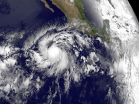Westall and colleagues use multi-scale methods to document the simultaneous presence of diverse types of microorganisms, including phototrophs and chemotrophs, directly interacting with coastal volcanic sediments that were bathed by hydrothermal fluids. They note that the hydrothermal fluids acted as a major nutrient source for the chemotrophic microbial communities and thus strongly controlled their development and distribution, while distribution of the photosynthetic biofilms was, of course, controlled by access to sunlight.
The silica-rich hydrothermal fluids also contributed to the rapid fossilization of the microbes and lithification of the sediments, fixing the diversity of microbial life and their interactions with the sediments for posterity. Westall and colleagues thus show that intricate microbe-sediment systems are deep-rooted in time and that at least some early life may indeed have been thermophilic.
FEATURED ARTICLE Archean (3.33 Ga) microbe-sediment systems were diverse and flourished in a hydrothermal context
Frances Westall et al., Centre de Biophysique Moléculaire (CBM), Centre National de la Recherche Scientifique (CNRS), Orléans, France. Published online ahead of print on 26 May 2015; http://dx.doi.org/10.1130/G36646.1. This article is OPEN ACCESS online.
Other recently posted GEOLOGY articles (see below) cover such topics as 1. Microbial sulfates and anaerobic methane oxidation;
2. Intraplate seismicity in northern Central Europe induced by the last glaciation; and
3. Long-term changes in precipitation recorded by magnetic minerals in speleothems.
GEOLOGY articles published online ahead of print can be accessed online at http://geology.gsapubs.org/content/early/recent. All abstracts are open-access at http://geology.gsapubs.org/; representatives of the media may obtain complimentary articles by contacting Kea Giles at the address above.
Please discuss articles of interest with the authors before publishing stories on their work, and please make reference to GEOLOGY in articles published. Contact Kea Giles for additional information or assistance.
Non-media requests for articles may be directed to GSA Sales and Service, gsaservice@geosociety.org.
A unique isotopic fingerprint of sulfate-driven anaerobic oxidation of methane
Gilad Antler et al., Department of Earth Sciences, University of Cambridge, Cambridge, UK. Published online ahead of print on 26 May 2015; http://dx.doi.org/10.1130/G36688.1.
Methane is a highly effective greenhouse gas, whose major natural reservoir is marine sediments. Fortunately, the anaerobic oxidation of methane, when coupled with microbial sulfate reduction, has been shown to consume about 90% of methane in marine sediments, preventing its release to the atmosphere. However, the mechanism of this process is still enigmatic. In this study, Gilad Antler and colleagues demonstrate, using stable isotopes, that a unique isotopic signature emerges during microbial sulfate reduction coupled to methane oxidation in bubbling cold seeps. This isotope signature differs from the one that is measured when sulfate is reduced by either organic matter oxidation or by a slower, diffusive flux of methane within marine sediments. Antler and colleagues suggest that this distinct fingerprint is the product of a very efficient microbial sulfate metabolism able to keep up with the high supply of methane.
Intraplate seismicity in northern Central Europe is induced by the last glaciation
Christian Brandes et al., Leibniz Universität Hannover, Germany. Published online ahead of print on 27 May 2015; http://dx.doi.org/10.1130/G36710.1.
Northern Central Europe is far away from tectonic plate boundaries and generally regarded as an area where earthquakes, especially those that are felt by people, rarely happen. Nevertheless, several strong historic earthquakes are documented over the last 1200 years in this area. Some of these earthquakes have caused distinct damages. In our study, we observed that many of the historic earthquakes occurred along old faults, which were active some 80 million years ago. To understand the mechanism that caused the historic earthquakes along these old faults, we simulated numerically how the crust got pushed down by the weight of the ice sheet during glaciation and the rebound of the crust causing earthquakes during and after deglaciation. The results of the simulations suggest that the historic earthquakes in northern Central Europe were induced by the melting of the Scandinavian ice sheet at the end of the last ice age. Novelties are that some of these earthquakes took place outside the former ice-covered area and that we can provide the link between the earthquakes that took place during and after deglaciation and those that occurred quite recently over the last 1200 years.
Evaluation of controls on silicate weathering in tropical mountainous rivers: Insights from the Isthmus of Panama
Steven T. Goldsmith et al., Villanova University, Villanova, Pennsylvania, USA. Published online ahead of print on 26 May 2015; http://dx.doi.org/10.1130/G36082.1.
Several recent studies have shown that small mountainous rivers (SMRs) deliver a disproportionate quantity of solutes (i.e., chemical weathering constituents) to the global ocean; however, these studies collected samples over a limited spatial and temporal scale and thus are unable to examine controls on delivery. In this new study for Geology, Steven Goldsmith and colleagues use an unprecedented high-resolution, multi-year sampling effort across the Isthmus of Panama to significantly advance our understanding of the controls on silicate rock weathering in tropical SMRs. This study addresses this knowledge gap and reveals strong links between chemical weathering and runoff/precipitation, mean elevation, physical weathering rates and stream gradient, thereby verifying the importance of runoff and physical erosion in maintaining elevated weathering rates on SMRs. Furthermore, the correlation observed between chemical weathering and forest land cover and forest carbon stock suggests a climatological and biological link that has not been previously documented and warrants further attention. Finally, the report is timely and contributes substantially to a novel perspective emerging in recent studies suggesting carbon dioxide drawdown from the weathering of silicate rock, in particular andesite lithology, should be considered separately when calculating global carbon dioxide drawdown values from silicate rock weathering.
Giant Kiruna-type deposits form by efficient flotation of magmatic magnetite suspensions
Jaayke L. Knipping et al., University of Michigan, Ann Arbor, Michigan, USA. Published online ahead of print on 19 May 2015; http://dx.doi.org/10.1130/G36650.1.
Increasing demand for building materials, technological products, and a shift toward using more renewable resources requires a better understanding of iron and rare earth element ore deposit formation. Kiruna-type iron oxide-apatite (IOA) deposits are valuable sources of these metals, yet there is vigorous debate about how they formed. Thus, Jaayke Knipping and colleagues investigated the representative Kiruna-type IOA deposit Los Colorados in Chile by measuring oxygen and iron isotope data as well as performing high-resolution geochemical analysis of magnetite. Their findings allowed the development of a new formation model in which flotation of igneous magnetite through bubble attachment represents the first step of iron enrichment, followed by precipitation of magmatic-hydrothermal magnetite on the rims of the igneous crystals. The Atacama fault system may have served as conduit for the efficient ascent and deposition of such magmatic magnetite suspensions that may have also formed the approx. 50 other similar deposits throughout Northern Chile.
Long-term changes in precipitation recorded by magnetic minerals in speleothems
Mark D. Bourne et al., University of Minnesota, Minneapolis, Minnesota, USA. Published online ahead of print on 19 May 2015; http://dx.doi.org/10.1130/G36695.1.
Cave deposits such as stalagmites are important archives of past climate. With the ability to provide high-resolution, continuous records that can be accurately dated, stalagmites are an attractive archive for reconstructing past changes in precipitation and temperature. As stalagmites grow, they incorporate small amounts of a magnetic mineral called magnetite. Magnetite is formed in soils overlying caves and can be transported to the caves and stalagmites by drip-water percolating through the rock. The formation of magnetite in soils is principally controlled by the amount of precipitation the soil receives. Now, Mark Bourne of the Institute for Rock Magnetism at the University of Minnesota and colleagues demonstrate how measurements of stalagmite magnetism can be used to reconstruct changes in precipitation over geological time. Using a stalagmite from Buckeye Creek Cave in West Virginia, USA, they observed that the amount of magnetite in the stalagmite tracked long-term changes in the amount of summer precipitation in West Virginia. This study shows how magnetic measurements on other stalagmites have the potential to document local environmental changes occurring in response to regional and global climate change.
Duration and dynamics of the best orbital analogue to the present interglacial
Biagio Giaccio et al., Istituto di Geologia Ambientale e Geoingegneria, Consiglio Nazionale delle Ricerche (CNR), Monterotondo, Rome, Italy. Published online ahead of print on 19 May 2015; http://dx.doi.org/10.1130/ G36677.1.
During the last million years, cyclical variation of Earth's orbit has caused changes in the amount of solar energy that heats our planet, producing a cycle of warm and cold periods, known as interglacials and glacials. Earth is presently in an interglacial period, the Holocene, which began 11,700 years ago. Past periods during which Earth's orbital configuration was similar to the present are considered climatic analogues for the Holocene and provide a natural basis for evaluating its expected duration. The study of Italian lake sediments, which preserve a detailed history of climate variability during the best Holocene analogue in the Mediterranean area, shows that this 800,000-year-old interglacial lasted for a time comparable to that elapsed since the beginning of the Holocene, which therefore should be close to its end and the start of a new glacial. However, greenhouse gas concentrations at that time were significantly lower than preindustrial levels, suggesting that the current interglacial has been prolonged by progressive CO2 increase during the last 6,000 to 8,000 years. This difference in CO2 concentration would have been enough to drastically deviate the intrinsic climate histories of the two otherwise analogous periods, highlighting the high sensitivity of climate to greenhouse gases.
Foreland basin stratigraphic control on thrust belt evolution
James B. Chapman and Peter G. DeCelles, University of Arizona, Tucson, Arizona, USA. Published online ahead of print on 19 May 2015; http://dx.doi.org/10.1130/G36597.1.
Mountains subtly depress Earth's crust around them, creating a moat or basin. This basin slowly fills with sand and sediment that washes down from the mountains. Because sediment breaks down as it travels away from the mountains, the area furthest from the mountains accumulate the smallest-sized sediment, often mud and clay. In contrast, the areas closest to the mountains accumulate coarse-grained sediment, including pebbles to boulders. As mountain belts grow and expand outward, the parts of the basin that were once located far from the mountain front move closer. The areas where fine-grained sediment was previously deposited now have coarser-grained sediment deposited on top of those older deposits. When these deposits consolidate to form rocks, the juxtaposition of different grain sizes creates rock layers with different material properties. Eventually, a growing mountain belt may incorporate these layers into the mountain by faulting and uplift. Research presented here by James Chapman and Peter DeCelles shows that these new faults are most likely to break the rock layers that consist of the finest-sized grains, the mudstone and shale. By understanding the processes that control the formation of the basins that accumulate sediment, geoscientists may be able to predict where new faults occur and how mountain belts evolve.
Gas-controlled seafloor doming
Stephanie Koch et al., GEOMAR Helmholtz Centre for Ocean Research, Kiel, Germany. Published online ahead of print on 19 May 2015; http://dx.doi.org/10.1130/G36596.1.
Cold vents are ubiquitous seabed features along all continental margins, hosting unique ecosystems that play a critical role in the global carbon cycle. Combining different geophysical field data with geomechanical theory, Stephanie Koch and colleagues elucidate the evolutionary stages of seep formation and explain the observed morphological structures (from deep methane gas migration through gas escape routes to seabed doming and breaching of the seafloor). Koch and colleagues quantify the underlying process parameters for seeps at the Hikurangi Margin offshore New Zealand. Thus, the study allows geoscientists to differentiate the possible modes of methane seepage, i.e. upward flow of methane-charge porewater and free gas, because the observed seafloor doming can only be produced by gas migration. This is also in line with the interpretation of geochemical data from Hikurangi seeps.
Reaction infiltration instabilities in experiments on partially molten mantle rocks
Matej Pec et al., University of Minnesota, Minneapolis, Minnesota, USA. Published online ahead of print on 19 May 2015; http://dx.doi.org/10.1130/G36611.1.
If a reactive fluid percolates through a dissolvable matrix, the reaction front can either propagate as a stable planar layer or become unstable and form preferred flow paths. The preferred flow paths emerge from the background flow due to a positive feedback between flow and reaction, which locally increases the permeability of the matrix. Since the reaction alters the composition of the matrix, reactive fluid flow can form patterns that can be recognized long after the fluid flow has ceased. In nature, a variety of patterns are interpreted to form by such processes -- from cave systems in carbonate rocks to melt-rich channels in the partially molten mantle. Pec and colleagues have designed a new experimental set-up that allows them to systematically study the channelization of a reactive melt flowing through a partially molten mantle rock. While the mineralogical composition of the resulting channels was in broad agreement with natural observations, the three dimensional morphology of the channels was not. These observations indicate that stress as well as reaction play an important role for melt channelization in nature.
Fluid flux melting generated postcollisional high Sr/Y copper ore-forming water-rich magmas in Tibet
Yong-Jun Lu et al., Centre for Exploration Targeting and Australian Research Council Centre of Excellence for Core to Crust Fluid Systems (CCFS), University of Western Australia, Crawley, Western Australia, Australia. Published online ahead of print on 19 May 2015; http://dx.doi.org/10.1130/G36734.1.
The Miocene Gangdese porphyry copper belt in southern Tibet developed in the Indo-Asian continental collision zone and is a typical porphyry belt in a collisional setting. These deposits in southern Tibet are genetically associated with dacitic-rhyolitic intrusions with unusually high Sr/Y ratios (>40), which have been attributed widely to dry melting of garnet-amphibolite in a thickened lower crust. To test this hypothesis, we utilize a geohygrometer for granitoid rocks to examine the hydration state of copper ore-forming high Sr/Y magmas. The results show that these Tibetan high-Sr/Y magmas had dissolved water contents greater than 10 wt%, which considerably exceeds the water supply by dry melting of basaltic amphibolites (max. of 6.7 +/- 1.4 wt%). We advocated alternatively that the high-Sr/Y dacitic-rhyolitic porphyries in southern Tibet are residually water-enriched, high-pressure differentiation products of hydrous mafic partial melts of Tibetan mantle. Our new model implies that porphyry Cu deposits in continental collision zones have similar origin to their counterparts in other tectonic settings such as magmatic arcs in circum Pacific region. Therefore, a universal exploration model may be applied all over the world to search for porphyry deposits.
The Miocene Galápagos ash layer record of Integrated Ocean Drilling Program Site U1381: Ocean-island explosive volcanism during plume-ridge interaction
J.C. Schindlbeck et al., GEOMAR Helmholtz Centre for Ocean Research Kiel, Germany. Published online ahead of print on 26 May 2015; http://dx.doi.org/10.1130/G36645.1.
Highly explosive Plinian eruptions are considered to be produced predominantly at subduction zone-related volcanic arcs. In contrast, this study by J.C. Schindlbeck shows that such type of volcanism can also be common at ocean islands. Evidences for this were discovered in form of abundant ash layers in a Miocene sediment package drilled during IODP Expeditions 334 and 344 at Site U1381, offshore Costa Rica. The geochemical provenance study of these ashes link their origin to the Galápagos hotspot. Schindlbeck and colleagues show that all these ash layers must be the product of highly explosive Miocene Galápagos volcanism and that their occurrence is controlled by plume-ridge interaction.
Organic carbon burial efficiencies in sediments: The power law of mineralization revisited
Sergei Katsev, Large Lakes Observatory and Department of Physics, University of Minnesota, Duluth, Minnesota, USA, and Sean A. Crowe, University of British Columbia, Vancouver, British Columbia, Canada. Published online ahead of print on 26 May 2015; http://dx.doi.org/10.1130/G36626.1.
The bottom sediments of lakes and oceans act as biogeochemical reactors that slowly incinerate the organic material that rains down from the water column, converting it to CO2. It is the efficiency of this burndown that determines how much of the organic carbon is removed from circulation by burial into deeper sediments. Such burial is the main factor that over geologic eons regulates atmospheric oxygen levels, which varied widely over Earth's history. The carbon decomposition rates have been previously described for modern marine sediments as a simple function of the organic material's age. Using data from freshwater lakes, Sergei Katsev and Sean Crowe show that a similar relationship holds for a much wider range of water chemistries, such as those in the oceans of the geologic past. A small correction, which accounts for the acceleration of rates in the presence of oxygen, makes the relationship consistent with the observed higher burial efficiencies under anoxic conditions. As it then becomes possible to calculate these efficiencies theoretically, extrapolations suggest that the anoxic deep ocean sediments during the Precambrian buried 6 to 40 times more of the deposited organic carbon than the oxygenated sediments of today, potentially allowing for faster variations in the atmospheric oxygen levels.
The dynamic reference frame of rivers and apparent transience in incision rates
Sean F. Gallen et al., University of Michigan, Ann Arbor, Michigan, USA; and Geological Institute, ETH Zurich, Zurich, Switzerland. Published online ahead of print on 26 May 2015; http://dx.doi.org/10.1130/G36692.1.
For more than a century, geologists have exploited river terraces to better understand fluvial, tectonic, and climatic processes. However, an apparent dependence of river incision rate on terrace age has been noted for geochronologically dated river terrace sequences. The cause of time-dependent incision rates is unclear, but it is argued to arise from the stochastic nature of river incision. If correct, the utility of river terraces as tectonic and climatic archives is diminished. In this new paper for Geology, Sean Gallen and colleagues present an alternative hypothesis, showing that time-dependent incision rates can arise from a systematic, yet easily corrected, bias that is introduced into the measurement of terrace height above a streambed. Noting that the elevation of a streambed oscillates to accommodate terrace formation, they show that measured average incision rates are inherently time dependent because the streambed elevation varies. They find that the position of the modern streambed dictates the degree to which incision rates will be skewed and that this bias can be removed by calculating incision with respect to other terraces, rather than the modern river channel. This study suggests that, when the mobility of streambed elevation is account for, river terraces can faithfully be used to interpret tectonic and climatic processes.
Climate, dust, and fire across the Eocene-Oligocene transition, Patagonia
Peter A. Selkin et al., School of Interdisciplinary Arts and Sciences, University of Washington, Tacoma, Washington 98402, USA, http://dx.doi.org/10.1130/G36664.1.
From the abstract: The Eocene-Oligocene transition (EOT) is typically interpreted as a time of drastic global cooling and drying associated with massive growth of a glacial icecap in Antarctica and the shift to an "icehouse" climate. The effects of this transition on the terrestrial environments, floras, and faunas of the Southern Hemisphere, however, have been unclear. Here we document simultaneous changes in fire regime and plant community in Patagonia, Argentina. Decreases in the concentration of magnetite in loessites from the Eocene-Oligocene Vera Member of the Sarmiento Formation correlate with decreases in the fraction of burnt palm phytoliths as well as more consistently palm-dominated phytolith assemblages. Association of magnetite and burnt palm phytoliths suggests intense wildfires, which appear to have been suppressed for ~200 k.y. shortly after the EOT. The disappearance of fire-related characteristics near the EOT is possible if changes in regional wind patterns -- consistent with observed changes in sediment particle sizes -- caused changes in seasonal precipitation. These results imply a more important role for fire in structuring Eocene-Oligocene landscapes than previously thought.
Porphyry-epithermal Au-Ag-Mo ore formation by vapor-like fluids: New insights from geochemical modeling
Nicole C. Hurtig and Anthony E. Williams-Jones, McGill University, Montreal, Québec, Canada. Published online ahead of print on 19 May 2015; http://dx.doi.org/10.1130/G36685.1.
From the abstract: Shallow magmatic-hydrothermal systems are characterized by steep gradients in temperature and pressure, and because the fluid is of low density and highly compressible, the solubility of ore minerals in these systems varies considerably as a function of both temperature and pressure. We use novel pressure- and temperature-dependent experimentally derived thermodynamic data to geochemically model the transport and deposition of Au, Ag, and Mo by vapor and low- to intermediate-density supercritical fluids in the context of Au and Mo porphyry and A u-Ag epithermal ore formation. The results show that there is a strong compositional control on the Au/Mo ratio of the parental ore fluid, which can explain Au-Mo zoning in porphyry ore deposits and the formation of Au-rich and Mo-rich subtypes. Gold solubility reaches a maximum between 320 degrees C and 500 degrees C, depending on the fluid density, whereas Mo and Ag concentrations decrease with decreasing temperature and pressure. These differences in mineral solubility help explain the fractionation of Au from Ag and Mo and the preferential mobilization of Au into sites of epithermal ore deposition. Application of this modeling of metal solubility in vapor-like fluids offers an important opportunity for understanding individual ore-forming hydrothermal systems and determining the limiting factors for metal enrichment.
INFORMATION:
http://www.geosociety.org/



